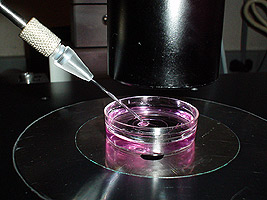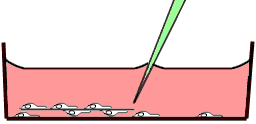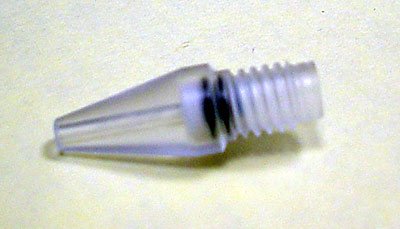The Analytical Imaging Facility has access to four Eppendorf microinjection systems that all essentially the same but differ slightly in vintage and functions.
One system is typically installed on CCD#4.
The others float from station to station. They may be used for microinjection or translocation pipette assays.
Microinjection instructions
Setup Checklist:
Any time you walk away from the station, please |
 |
 If cells are growing on coverslips in
culture dishes, there are three surfaces that the cells may be living on. They may
adhere to the bottom of the plastic dish, to the bottom of the coverslip, or to the top of
the coverslip. If cells are growing on coverslips in
culture dishes, there are three surfaces that the cells may be living on. They may
adhere to the bottom of the plastic dish, to the bottom of the coverslip, or to the top of
the coverslip. |
 You must be focused on the cells
on the top of the coverslip because the needle has access only to the top layer of cells. You must be focused on the cells
on the top of the coverslip because the needle has access only to the top layer of cells. |
 The simplest way to set a Z limit is to
lightly touch the side of one of the cells. Then type the magic key sequence:
set; z-limit; enter. The simplest way to set a Z limit is to
lightly touch the side of one of the cells. Then type the magic key sequence:
set; z-limit; enter.
or on the newer systems, just by tapping the "Limit" button. |
If this Z limit is slightly too high or slightly too low, you can modify the Z limit in
fractions of a micrometer.

To cancel a Z limit,![]()
![]() .
.
If you want to label the cells with a fluorescent dextran so you can see immediately the amount injected.
Standard 0.5-1 mg/ml Dextran 10,000 MW lysine fixable (Molecular Probes; stays after fixation, handy for IF). You can go much lower with the dextran if your solution is extra thick (we have used about 10 times less when he was injecting DNA in the nucleus). Standard is 1:30 from 2 mg/ml stock.
Checklist!! You may
need to provide the following things
for microinjection:
Need to locate injected cells later? EMS sells Cell-Vu gridded coverslips(cat. no. 72264-23). 1-800-523-5874. We use Bellco's 22x22mm etched coverslips #1916-92525. I think we got them There are coveslips from eppendorf. The name is CELLocate
coverslips.


The container at the left holds more than 30 needles and is available commercially. The container at the
right is a simple culture dish with plasticine (non-drying clay) to hold the needles so
that the tips cannot be damaged.
Needles may be coated to make them more slippery.

The Dept. Anatomy incubator in the common equipment room is
available for AIF use. All dishes in this incubator must be free clearly labeled
with your lab and the date. The culturing hoods may be available by special
request; do not use them without specific permission from the lab designated to the hood.
through Fisher. http://www.bellcoglass.com/
Their coverslips have photoetched grids with 520 alphanumerically
coded squares.
Microinjection needle coating instructions
If you pull your own needles, you may find that they stick less to the cells if you treat them as follows:
You will need
If you supply your own needles...
 |
 |
Therefore, all microinjection users who use their own needles instead of the commercially available Eppendorf ones need to purchase their own grip head. We sell them at cost.
Ask Michael in advance and he will give you a grip head in a labeled baggie (so you may clip it to your notebook).
Selected Bibliography of papers using microinjection apparatus in AIF:
Other Links